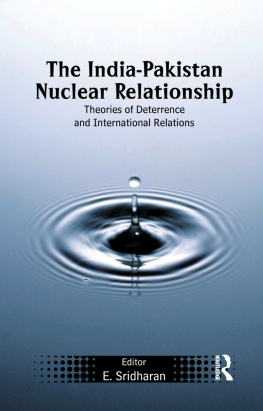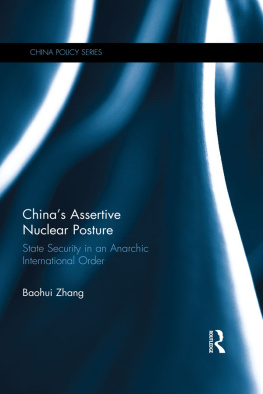NUCLEAR STRATEGY IN THE MODERN ERA
PRINCETON STUDIES IN INTERNATIONAL HISTORY AND POLITICS
Series Editors
G. John Ikenberry and Marc Trachtenberg
RECENT TITLES
Nuclear Strategy in the Modern Era: Regional Powers and International Conflict by Vipin Narang
The Cold War and After: History, Theory, and the Logic of International Politics by Marc Trachtenberg
Liberal Leviathan: The Origins, Crisis, and Transformation of the American World Order by G. John Ikenberry
Worse Than a Monolith: Alliance Politics and Problems of Coercive Diplomacy in Asia by Thomas J. Christensen
Politics and Strategy: Partisan Ambition and American Statecraft by Peter Trubowitz
The Clash of Ideas in World Politics: Transnational Networks, States, and Regime Change, 15102010 by John M. Owen IV
How Enemies Become Friends: The Sources of Stable Peace by Charles A. Kupchan
1989: The Struggle to Create PostCold War Europe by Mary Elise Sarotte
The Struggle for Power in Early Modern Europe: Religious Conflict, Dynastic Empires, and International Change by Daniel H. Nexon
Strong Borders, Secure Nation: Cooperation and Conflict in Chinas Territorial Disputes by M. Taylor Fravel
The Sino-Soviet Split: Cold War in the Communist World by Lorenz M. Lthi
Nuclear Logics: Contrasting Paths in East Asia and the Middle East by Etel Solingen
Social States: China in International Institutions, 19802000 by Alastair Iain Johnston
Appeasing Bankers: Financial Caution on the Road to War by Jonathan Kirshner
The Politics of Secularism in International Relations by Elizabeth Shakman Hurd
Unanswered Threats: Political Constraints on the Balance of Power by Randall L. Schweller
Producing Security: Multinational Corporations, Globalization, and the Changing Calculus of Conflict by Stephen G. Brooks
Driving the Soviets up the Wall: Soviet-East German Relations, 19531961 by Hope M. Harrison
NUCLEAR STRATEGY IN THE MODERN ERA
Regional Powers and International Conflict
Vipin Narang
PRINCETON UNIVERSITY PRESS
Princeton and Oxford
Copyright 2014 by Princeton University Press
Published by Princeton University Press, 41 William Street, Princeton, New Jersey 08540
In the United Kingdom: Princeton University Press, 6 Oxford Street, Woodstock, Oxfordshire OX20 1TW
press.princeton.edu
Jacket photo: LGM-118As first stage solid rocket ignites as the missile clears the silo. National Museum of the US Air Force / USAF photo.
All Rights Reserved
ISBN 9780691159829
ISBN (pbk.) 9780691159836
Library of Congress Cataloging-in-Publication Data
Narang, Vipin.
Nuclear strategy in the modern era : regional powers and international conflict / Vipin Narang.
pages cm. (Princeton studies in international history and politics)
Includes bibliographical references and index.
ISBN 978-0-691-15983-6 (pbk.) ISBN 978-0-691-15982-9 (hardcover) 1. Nuclear weaponsGovernment policyCase studies. 2. Nuclear warfareGovernment policyCase studies. 3. Deterrence (Strategy)Case studies. 4. Security, InternationalCase studies. I. Title.
U264.N36 2014
355.02'17dc23
2013034255
British Library Cataloging-in-Publication Data is available
This book has been composed in Sabon LT Std
Printed on acid-free paper.
Printed in the United States of America
10 9 8 7 6 5 4 3 2 1
CONTENTS
FIGURES AND TABLES
FIGURES
TABLES
ACKNOWLEDGMENTS
This book would not have been possible without the support of countless mentors, colleagues, friends, and institutions. The genesis of my interest in security studies began when I was an undergraduate chemical engineer interested in international security. Two key individuals were responsible for shepherding my shift from engineer to political scientist. First, Scott Sagan took a chance on me as an undergraduate and has never wavered in his support, being both tough and caring when necessary. I am forever grateful to Scott and Stanfords Center for International Security and Cooperation for starting my trajectory, and welcoming me back in 2012 as a Stanton Junior Faculty Fellow. I am fortunate to have Scott as a mentor, colleague, and friend. The second catalyst at Stanford was Taylor Fravel, who was the first teaching assistant I had in an international relations course in 1999. He pushed me to consider writing an undergraduate thesis in international security, and I have not looked back since. We have teamed up again at MIT, where he has provided constant guidance and support, and is a trusted friend and colleague. My career, let alone this book, would not have been possible if not for Scott and Taylor.
This book began when I was a doctoral student in Harvards Government Department. I first thank Yuen Foong Khong, my Oxford MPhil advisor, for pushing me to pursue a PhD. At Harvard, my advisors, Stephen Rosen, Alastair Iain Johnston, and, remotely, Allan Stam, provided tremendous support, humor, and guidance. Steve, in particular, supported my decision to write a dissertation on nuclear strategy when almost everyone else was telling me the subject was dead. Iain was a role model in academic and personal integrity, and I always value his advice. Al had to work especially hard, since he advised the dissertation remotely, but his input was critical to ensuring that my research design and methods met his high standards. Other faculty at Harvard whose advice shaped this book include Bear Braumoeller, Mike Hiscox, Gary King, and Andy Kydd. My graduate student colleagues at Harvard who provided guidance and feedback through the years made the journey memorable: Tyson Belanger, Amy Catalinac, Andrew Coe, Sheena Chestnut Greitens, Mike Horowitz, Andy Kennedy, Alex Liebman, Siddharth Mohandas, Becky Nelson, Jonathan Renshon, Erin Simpson, and Jane Vaynman. I thank the Paul and Daisy Soros Foundation, the Weatherhead Center, and the Smith Richardson Foundation for financial support during graduate school.
A number of individuals helped me during my time conducting research in South Asia over the years, often in the extremely hot summers, and I thank them for their time and efforts: Uday Bhaskar, Stephen Cohen, Sumit Ganguly, Jack Gill, Kapil Kak, Gaurav Kampani, Gurmeet Kanwal, Paul Kapur, Bharat Karnad, Feroz Hassan Khan, Michael Krepon, Arvinder Lamba, Pratap Bhanu Mehta, Anit Mukherjee, Raja Menon, Raja Mohan, Rostum Nanavatty, Shuja Nawaz, Arun Prakash, Srinath Raghavan, Shyam Saran, Vijay Shankar, the late K. Subrahmanyam, and several others who must remain anonymous.
Large portions of the book were critiqued and revised when I was a predoctoral fellow, and I thank the Olin Institute and the Belfer Center at Harvard for hosting me for two years. For tremendous help during these years, I want to thank Emma Belcher, Malfrid Braut-Hegghammer, Matt Bunn, Alex Debs, Alex Downes, Matthew Fuhrmann, Vaidya Gundlupet, Matthew Kroenig, Jason Lyall, Sean Lynn-Jones, Marty Malin, Steve Miller, Negeen Pegahi, Daryl Press, Josh Rovner, Karthika Sasikumar, Todd Sechser, Maya Tudor, Elizabeth Saunders, Ben Valentino, and Steve Walt. In these years, I met two colleagues who became great friends and who painstakingly read multiple iterations of this manuscript: Paul Staniland and Caitlin Talmadge.
I finalized this book manuscript while working at my first job at MIT. I owe the MIT Department of Political Science and the Security Studies Program a huge debt of gratitude for their support, and for providing me with an intellectual home. This book would not have been possible if not for the hallway chats, eyes on the page, and moral support of Barry Posen, Steve Van Evera, Dick Samuels, Rick Locke, and of course Taylor. MIT hosted a book workshop that allowed Scott, Charlie Glaser, and Bob Jervis to spend a day helping me improve the book immeasurably, along with Barry, Steve, and Taylor. I thank them all for coming on a bitterly cold winter day, assembling more intellectual firepower on nuclear strategy in one room than I could have ever dreamed of. My graduate student research assistants, notably the extremely capable trio of Mark Bell, Chris Clary, and Nick Miller, provided excellent research and editorial assistance. Workshop participants at the University of Chicago, Dartmouth, George Washington University, Princeton University, Yale University, University of Virginia, and the University of WisconsinMadison, where I was also a faculty member for a year and met great colleagues and friends, have provided critical constructive feedback. The final stop on my journey with this book, perhaps appropriately, was back home where my career began, at Stanfords CISAC, where the Stanton foundation generously allowed me to spend a year as junior faculty fellow. The year there with Scott, Lynn Eden, Malfrid, Thomas Hegghammer, David Holloway, Rifaat Hussain, and Feroz Hassan Khan was crucial as I worked through the final revisions on the manuscript. I thank them for welcoming me, and for a wonderfully enriching year back on The Farm.
Next page











